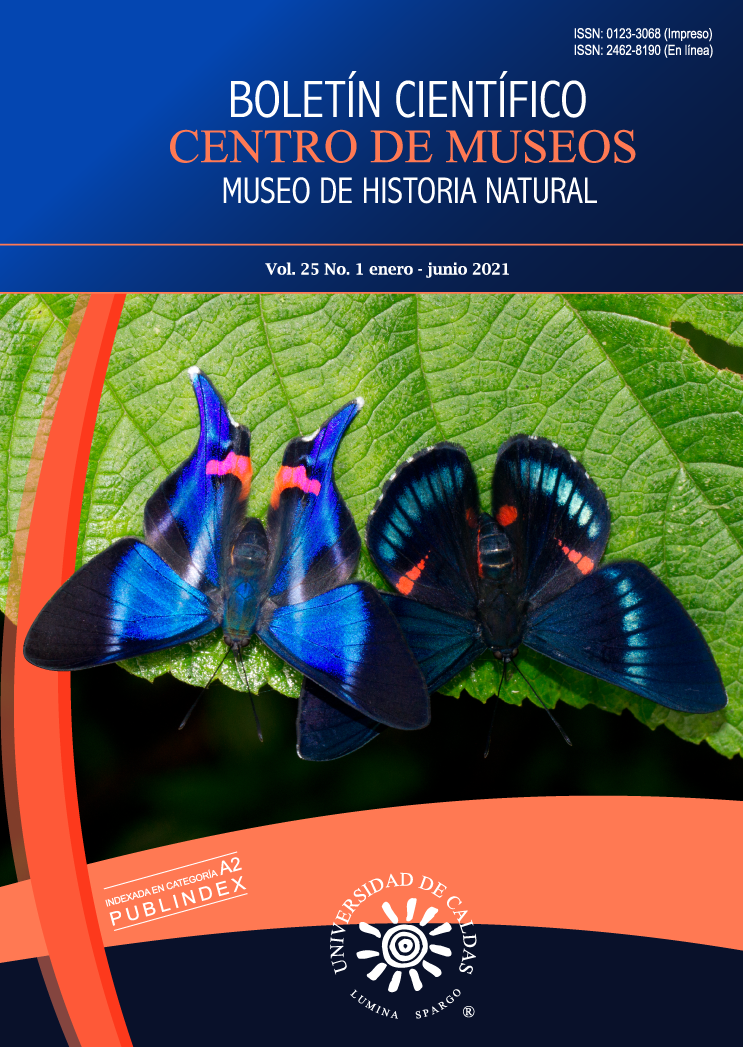Authors
Abstract
Objective. The external morphology and biology of the immature stages of Hamadryas chloe (Stoll, 1787) recorded in Dalechampia scandens (Euphorbiaceae) in the Paway Natural Reserve zoo, Mocoa, Putumayo are described. Methodology. The morphological characters are illustrated and described to disclose their life cycle or metamorphosis. Scope. the observations were made from March to September 2018. Results and conclusions. The immature stages are the typical ones belonging to the genus of nymphalids Hamadryas Hübner present in Tropical America.
References
DeVries, P. J. (1987). The butterflies of Costa Rica and their natural history: Papilionidae, Pieridae, Nymphalidae. Princeton University Press.
Hoskins, A. (2012). Learn About Butterflies: the complete guide to the world of butterflies and moths. Recuperado de www.learnaboutbutterflies.com, consultado el 20 de octubre de 2018.
Jenkins, D.W. (1983). Neotropical Nymphalidae. I. Revision of Hamadryas. Bulletin of the Allyn Museum, 81, 1–146.
Keiper, R. (1969). Behavioral adaptations of cryptic moths. IV. Preliminary studies of species resembling dead leaves. Journal of Lepidopterists Society, 23, 205-210.
Lamas, G. (2004). Checklist: part 4A. Hesperioidea – Papilionoidea. In: J. B. Heppner (Ed.). Atlas of Neotropical Lepidoptera, vol. 5A. Association for Tropical Lepidoptera (pp. 238–239). Gainesville: Scientific Publishers
Marini-Filho, O. J. y Benson, W. W. (2010). Use of sound and aerial chases in sexualrecognition in Neotropical Hamadryas butterflies (Nymphalidae). Journal of Research on the Lepidoptera, 42, 5–12.
Monge-Nájera, J. (1988). Mariposas crípticas del Género Hamadryas (Lepidoptera: Nymphalidae): uso de sustrato, territorialidad, emisión de sonido y morfología (Tesis de maestría). Universidad de Costa Rica, San José, Costa Rica. 61 p.
Monge-Nájera, J. (1992) Clicking butterflies, Hamadryas, of Panamá: Their biology and classification (Lepidoptera, Nymphalidae). In: D. Quintero y A. Aiello (eds.). Insects of Panama and Mesoamerica: Selected Studies (pp. 567.572). Oxford: Oxford University.
Monge-Nájera, J. (1995). Mariposas que producen sonido: ¿cuál es la situación de Hamadryas (Nymphalidae) en Cuba? Cocuyo, 4, 11.
Monge-Nájera, J. y Hernández, F. (1993). A morphological search for the sound mech-anism of Hamadryas butterflies (Lepidoptera: Nymphalidae). Journal of Research on the Lepidoptera, 30, 196–208.
Monge-Nájera, J., Hernández, F., González, M. I., Soley, J., Araya, J. y Zolla, S. (1998). Spatial distribution, territoriality and sound production by tropical cryptic butterflies (Hamadryas, Lepidoptera: Nymphalidae): implications for the “industrialmelanism” debate. Revista de Biología Tropical, 46, 297–329.
Murillo-Hiller, L. R. (2011). The spiral organ responsible for producing sound signals, an essential taxonomic character in the phylogenetic analysis of the genus Hamadryas (Nymphalidae: Biblidinae): the case of Hamadryas chloe (Stoll) [1787] from South America. International Scholarly Research Notices, 1–3. https://doi.org/10.5402/2011%2F170829
Murillo-Hiller, L. Ricardo, Córdoba-Alfaro, J. (2013). Taxonomía e historia natural de las mariposas tronadoras Hamadryas spp. (Lepidoptera, Nymphalidae). Revista de ciencias, 17(1), 61-66. https://www.researchgate.net/deref/http%3A%2F%2Fdx.doi.org%2F10.25100%2Frc.v17i1.496
Otero, L. D. (1990). The stridulatory organ in Hamadryas (Nymphalidae): Preliminary obervations, 285-288.
Salazar, J. A. (2007). Catálogo de los Rhopalocera del Museo de Historia Natural (CM), Universidad de Caldas y de la colección J. Salazar (CJS), parte I con apuntes taxonómicos. Boletín Científico del Museo de Historia Natural de la Universidad de Caldas, 11, 206-259.
Yack, J. E., Otero, L. D., Danson, J. W., Surlykke, A. y Fullard, J. (2000). Sound production and hearing in the blue cracker butterfly Hamadryas feronia (Lepidoptera, Nymphalidae) from Venezuela. The Journal of Experimental Biology, 203, 3689–3702.

 PDF (Español)
PDF (Español)
 FLIP
FLIP























